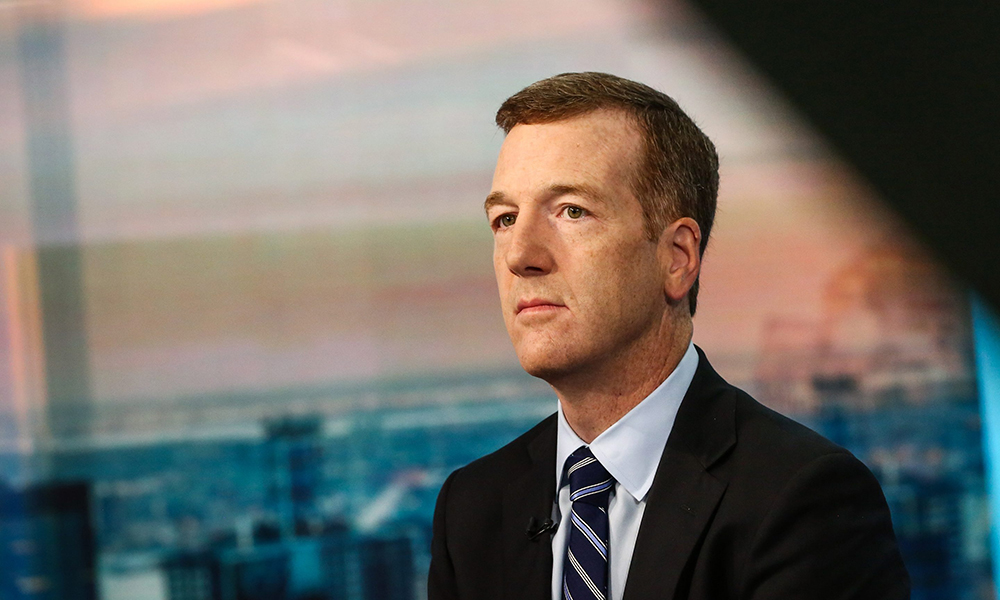
华尔街著名策略师迈克·威尔森认为,美国股市可能在年底迎来一波反弹,但他依旧认为到年底美股将低于目前的水平。
来自摩根士丹利(Morgan Stanley)的威尔森在周一的报告中坚持他对美股前景的谨慎立场,他坚持认为到2023年底,美股将下跌10%。威尔森在成功预测了股价暴跌之后,在机构投资者(Institutional Investor)去年的策略师排名中排在第一位。
他写道:“从技术层面,股票的平均表现已经出现了下跌趋势。买入的信号正在减弱,这意味着关键战术支撑位变得脆弱。”
作为美国最大的上市公司的基准指数,标普500指数在高度波动的9月份下跌了5%,本月已经稳步上涨。今年到目前为止,标普500指数已经反弹了约15%。
但威尔森坚持认为,实际情况并不像表面上那么简单。他指出,标普500指数中表现最好的公司是具有防御性品质的公司,例如有稳健现金流的公司,这意味着“在市场表面下隐藏着一种谨慎的基调”。
威尔森认为,华尔街向下修正收益预测,以及消费者信心不稳定性增加,也能支持他的预测,即到今年年底标普500指数将下跌到3,900点。
他在报告中表示:“公司的净利润、各种市场广度指标下跌、谨慎因素的领先、最近对公司收益的向下修正以及消费者信心的下降,都降低了第四季度股市反弹的概率。”
但这位资深投资者承认,这并不意味着股市会下跌。
尽管威尔森非常谨慎,他承认,虽然经济逆境正在削弱投资者的信心,依旧有许多投资者在购买股票,这可能在第四季度的某个时间点推动股市反弹。
他解释称:“今年,少数超大盘股的强势表现推动基准指数上涨,为了降低错过这波行情的可能性,许多人依旧倾向于持有多头头寸,并且可能多于他们想要持有的仓位。”他表示,如果在短期内维持当前的价格,这种情形可能持续存在,从而使2023年最后几个月股市“很有可能”出现反弹。
悲观预测
作为华尔街知名度最高的空头之一,威尔森对美国股市一直给出悲观预测。他在5月曾警告投资者,不要被标普500指数当时的反弹所欺骗。
然而,他的警告并非总是准确的。
今年早些时候,他预测美国股市将下跌20%,但后来他分析了为什么他的预测未能成真。
他在夏季的客户报告中承认:“我们错了。2023年,在通胀下降和成本降低的大环境下,股市估值上涨。”
在8月接受彭博社采访时,威尔森表示他“本应该相信自己的直觉”,在1月份修改他的市场预测。当时,他担心摩根士丹利的前景预测过于悲观。
他说道:“我们没有考虑到财政刺激措施的影响,这是一个严重错误。我们以为[政府]会在真正需要的时候出台财政刺激政策。”
威尔森一直预测2023年底标普500指数的目标点位为3,900点,较当前点位下跌约10%。
7月,他表示,他对2024年年中的基本情景预测是,标普500指数将下跌至约4,200点,较当前水平下跌3%。但在悲观情景下,他预测到明年6月,该蓝筹股指数将下跌至3,700点,这意味着要比当前水平下跌约15%。
尽管在2023年,与金融危机以后最糟糕的一年相比,标普500指数已经大幅反弹,但威尔森并非华尔街唯一一位在最近几个月对股市持更谨慎态度的策略师。
本月早些时候,摩根大通(JPMorgan)首席策略师警告称,股市即将暴跌20%,他表示他“不确定我们将如何避免”经济衰退。
有计算显示,标普500指数将下跌到3,000点以下,较当前水平下跌至少30%。
与此同时,高盛(Goldman Sachs)和花旗集团(Citigroup)等看好股市的华尔街机构也降低了对标普500指数年底价格目标的预测。
美国银行(Bank of America)9月的全球基金经理人调查显示,机构投资者并非“特别悲观”,但他们同样不感到乐观。此次调查的222名受访者管理的资产总额达到6,160亿美元。(财富中文网)
翻译:刘进龙
审校:汪皓
华尔街著名策略师迈克·威尔森认为,美国股市可能在年底迎来一波反弹,但他依旧认为到年底美股将低于目前的水平。
来自摩根士丹利(Morgan Stanley)的威尔森在周一的报告中坚持他对美股前景的谨慎立场,他坚持认为到2023年底,美股将下跌10%。威尔森在成功预测了股价暴跌之后,在机构投资者(Institutional Investor)去年的策略师排名中排在第一位。
他写道:“从技术层面,股票的平均表现已经出现了下跌趋势。买入的信号正在减弱,这意味着关键战术支撑位变得脆弱。”
作为美国最大的上市公司的基准指数,标普500指数在高度波动的9月份下跌了5%,本月已经稳步上涨。今年到目前为止,标普500指数已经反弹了约15%。
但威尔森坚持认为,实际情况并不像表面上那么简单。他指出,标普500指数中表现最好的公司是具有防御性品质的公司,例如有稳健现金流的公司,这意味着“在市场表面下隐藏着一种谨慎的基调”。
威尔森认为,华尔街向下修正收益预测,以及消费者信心不稳定性增加,也能支持他的预测,即到今年年底标普500指数将下跌到3,900点。
他在报告中表示:“公司的净利润、各种市场广度指标下跌、谨慎因素的领先、最近对公司收益的向下修正以及消费者信心的下降,都降低了第四季度股市反弹的概率。”
但这位资深投资者承认,这并不意味着股市会下跌。
尽管威尔森非常谨慎,他承认,虽然经济逆境正在削弱投资者的信心,依旧有许多投资者在购买股票,这可能在第四季度的某个时间点推动股市反弹。
他解释称:“今年,少数超大盘股的强势表现推动基准指数上涨,为了降低错过这波行情的可能性,许多人依旧倾向于持有多头头寸,并且可能多于他们想要持有的仓位。”他表示,如果在短期内维持当前的价格,这种情形可能持续存在,从而使2023年最后几个月股市“很有可能”出现反弹。
悲观预测
作为华尔街知名度最高的空头之一,威尔森对美国股市一直给出悲观预测。他在5月曾警告投资者,不要被标普500指数当时的反弹所欺骗。
然而,他的警告并非总是准确的。
今年早些时候,他预测美国股市将下跌20%,但后来他分析了为什么他的预测未能成真。
他在夏季的客户报告中承认:“我们错了。2023年,在通胀下降和成本降低的大环境下,股市估值上涨。”
在8月接受彭博社采访时,威尔森表示他“本应该相信自己的直觉”,在1月份修改他的市场预测。当时,他担心摩根士丹利的前景预测过于悲观。
他说道:“我们没有考虑到财政刺激措施的影响,这是一个严重错误。我们以为[政府]会在真正需要的时候出台财政刺激政策。”
威尔森一直预测2023年底标普500指数的目标点位为3,900点,较当前点位下跌约10%。
7月,他表示,他对2024年年中的基本情景预测是,标普500指数将下跌至约4,200点,较当前水平下跌3%。但在悲观情景下,他预测到明年6月,该蓝筹股指数将下跌至3,700点,这意味着要比当前水平下跌约15%。
尽管在2023年,与金融危机以后最糟糕的一年相比,标普500指数已经大幅反弹,但威尔森并非华尔街唯一一位在最近几个月对股市持更谨慎态度的策略师。
本月早些时候,摩根大通(JPMorgan)首席策略师警告称,股市即将暴跌20%,他表示他“不确定我们将如何避免”经济衰退。
有计算显示,标普500指数将下跌到3,000点以下,较当前水平下跌至少30%。
与此同时,高盛(Goldman Sachs)和花旗集团(Citigroup)等看好股市的华尔街机构也降低了对标普500指数年底价格目标的预测。
美国银行(Bank of America)9月的全球基金经理人调查显示,机构投资者并非“特别悲观”,但他们同样不感到乐观。此次调查的222名受访者管理的资产总额达到6,160亿美元。(财富中文网)
翻译:刘进龙
审校:汪皓
U.S. stocks could enjoy a year-end rally, according to Wall Street’s top strategist Mike Wilson—but he still believes shares will end the year lower than they are right now.
In a note on Monday, Morgan Stanley’s Wilson—who was ranked No. 1 in last year’s Institutional Investor survey after correctly predicting the selloff in stocks—stood by his cautious outlook for U.S. equities, doubling down on his prediction that stocks will shed 10% of their value by the end of 2023.
“The average stock has already broken down technically,” he wrote. “The signals are weaker and suggest key tactical support is vulnerable.”
The S&P 500—a benchmark for America’s biggest publicly listed companies—has made steady gains this month, after suffering a volatile September in which it plummeted by 5%. So far this year, the index has returned almost 15%.
However, Wilson insisted that all was not as it seemed, noting that companies with defensive qualities like strong cash flows were among the index’s best-performing stocks—which suggested there was “a cautious tone under the surface of the market.”
A decline in Wall Street earnings revisions, combined with consumer confidence being on much shakier ground, were also supporting Wilson’s projection that the S&P 500 will end this year at 3,900 points, he argued.
“The bottom line, the breakdown in various breadth measures, cautious factor leadership, the recent decline in earnings revisions and fading consumer confidence reduce the odds of a fourth-quarter rally,” he said in his note.
All was not necessarily lost, though, the veteran investor conceded.
Despite his own caution, Wilson acknowledged that many investors were still betting on stocks despite economic headwinds denting confidence—which could feed into a rally at some point in the fourth quarter.
“Many are still leaning more long than they would like to reduce the probability of missing out in a year in which narrow mega-cap strength has driven benchmarks,” he explained. If current prices hold in the short term, he said, that sentiment may be maintained—making it “more likely than not” that stocks would rally in the final months of 2023.
Bearish outlook
Wilson, one of Wall Street’s most prominent bears, has long been making gloomy predictions about U.S. stocks, warning investors in May not to be fooled by the rally that was unfolding across the S&P 500 at the time.
However, his warnings have not always come to fruition.
Earlier this year, he predicted that a 20% downturn was imminent for U.S. stocks—and has since reflected on why his projections missed the mark.
“We were wrong,” he conceded in a note to clients over the summer. “2023 has been a story of higher valuations amid falling inflation and cost-cutting.”
In an August interview with Bloomberg, Wilson said he “should have gone with his instinct” and revised his market calls in January when he feared that Morgan Stanley’s outlook was too bearish.
“We missed this fiscal impulse, that was a big mess on our part,” he said. “We thought the fiscal impulse would come at the time that [the government] really needed it.”
Wilson’s 2023 end-of-year price target for the S&P 500 has long stood at 3,900 points—a drop of around 10% from where it’s currently trading.
Back in July, he said his base case for mid-2024 was now for the S&P 500 to drop to around 4,200 points—a drop of just 3% from current levels. In a bear case scenario, however, he forecasted that the blue-chip index could plummet as low as 3,700 by next June, meaning they would shed almost 15% from where they are now.
Wilson isn’t a lone voice on Wall Street when it comes to taking a warier approach to stocks in recent months—despite the S&P 500 staging a strong recovery in 2023 from its worst year since the financial crisis.
Earlier this month, JPMorgan’s top strategist warned stocks could be about to nosedive 20%, saying he was “not sure how we’re going to avoid” a recession.
Some calculations suggest that the S&P 500 is headed below 3,000 points—which would be a decline of at least 30% from current levels.
Wall Street bulls Goldman Sachs and Citigroup, meanwhile, have lowered their year-end price targets for the S&P 500 index.
According to Bank of America’s September Global Fund Manager Survey—which polled 222 respondents who collectively manage assets worth $616 billion—institutional investors are not quite “extremely bearish,” but they aren’t feeling bullish either.






